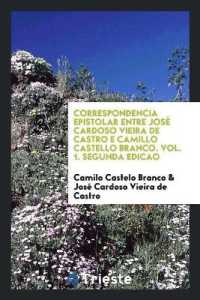- ホーム
- > 洋書
- > 英文書
- > History / World
Full Description
London's Waterfront and its World, 1666-1800 presents the results of archaeological excavations of 1974 to 1983 in the central waterfront area of the City of London. The archaeology of the port of London is considered on a wide scale, from the City down the Thames to Deptford. The Great Fire of London in 1666 prompted some changes to the topography of streets and buildings, but there were also many continuities in life and work. The waterfront changed during the 18th century as warehousing replaced houses. This process is illustrated by archaeological excavation, documentary study and the survival of plans of properties surveyed for land-owning institutions. The artefacts and pottery recovered from these sites include many pieces from overseas, and London's waterfront can be compared with those of other port cities in Europe, North America and the Caribbean. Perhaps in late 17th- and 18th-century London we can study urban tastes and consumption from an archaeological viewpoint. During this period London became the hub of the new British empire, but contributed to the exploitation of people from other lands known as slavery. The waterfront on both sides of the Thames was at the centre of the new empire.
Contents
Summary
1 The waterfront of the City of London, 1666 to 1800: introduction to the study
Conventions, methods and the archive
2 The port of London, 1666 to about 1750
Major public works on the City waterfront after the Great Fire
The reconstruction plans of Wren and Evelyn and the New Quay
London Bridge
Public buildings and places in central and eastern Thames Street
Transport networks: wharves, stairs and how shipping was managed; carmen and their carts
Conclusions: the structure of the port
3 The archaeological excavations of 1974-84
Thames Street above the Bridge, 1666-1780: the Swan Lane and Seal House excavations and their setting
Swan Lane (site A) - John Schofield, with contributions by Lyn Blackmore and Jacqui Pearce
Seal House (site B) - John Schofield, with contributions by Lyn Blackmore, Jacqui Pearce and Stephen Freeth
Fishmongers' Hall
New Fresh Wharf (site C) - John Schofield with contributions by Stephen Freeth
Billingsgate (site D): documentary evidence - Stephen Freeth
Billingsgate (site D): excavation - John Schofield, with contributions by I M Betts, Jacqui Pearce and Alan Pipe
4 Living and working in London, 1666 to 1750
Settlements and buildings along the Thames
Buildings, material culture and lifestyle in post-Fire London
Conclusions to this chapter
5 The waterfront from 1750 to 1800, and the growth of large-scale warehousing
Custom House, London Bridge, Billingsgate and the Coal Exchange, 1750-1800
Upstream of the Bridge 1750 to 1800
The growth of large-scale warehousing in the City from 1730 to 1800
The Sufferance Wharves and other wharves nearby
Public buildings as celebrations of empire in the 18th and early 19th centuries
6 London and slavery, to 1800
7 From 1796 to the 20th century
Congestion, the debates of 1796 and proposals
Nineteenth-century developments on the City waterfront and immediately to the east
8 London's connections with other ports, 1666 to 1800; post-medieval waterfront archaeology elsewhere
British ports and coastal shipping
Foreign and colonial ports
9 The port of London, 1666 to 1800: a summary and some questions for further research
General arguments
Detailed questions on the sites and their setting, 1666 to 1800
Overall conclusions
10 Specialist reports and appendices
Pottery and other artefacts - Jacqui Pearce and Lyn Blackmore
Post-medieval coins from Billingsgate - Julian Bowsher
Ceramic building material from Billingsgate - I M Betts
Cowrie shells from Billingsgate - Alan Pipe
Introduction and methodology
Inventories of Richard Beckford (1679) and Francis Minshull (1704) - Stephen Freeth
Résumé
Zusammenfassung
Documentary sources, bibliography and abbreviations
Primary Sources
Printed Sources and Abbreviations
Index








